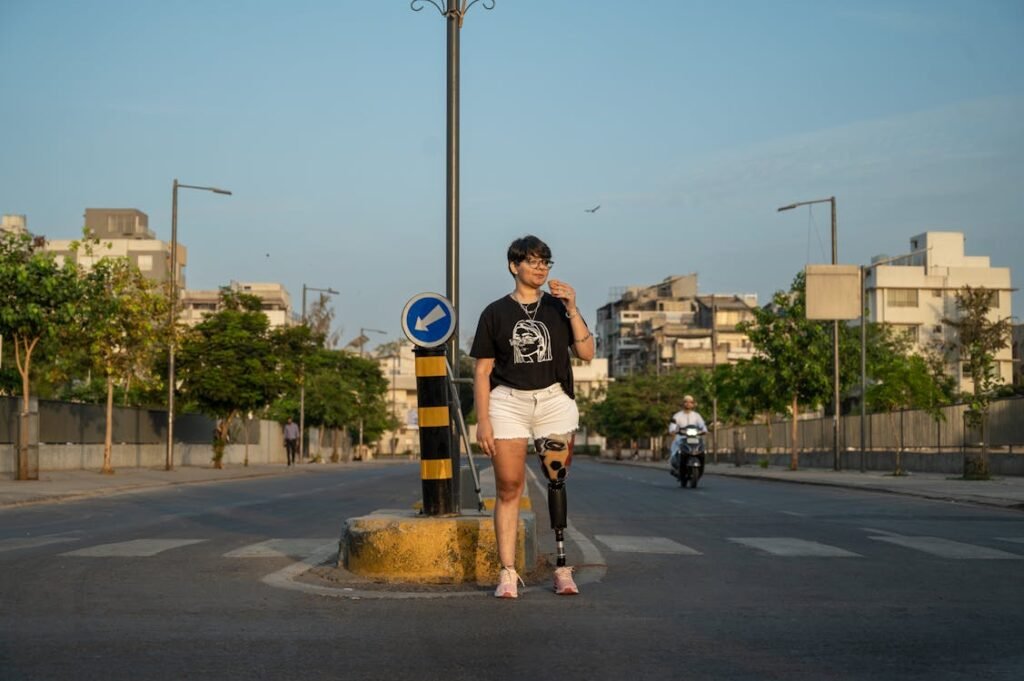Every step takes effort. But for someone with a lower limb amputation, that effort isn’t just physical — it’s a calculation. A quiet, constant balancing act between comfort, energy, and movement. One of the biggest parts of this equation is weight-bearing — how the body supports itself while walking, standing, or even shifting from one leg to another.
It’s something most people never think about. But for amputees, weight-bearing plays a huge role in how much energy they use just to move through daily life. If the body isn’t supported in the right way, walking can feel like dragging a heavy load uphill. But when weight-bearing is managed well, movement becomes smoother and less tiring.
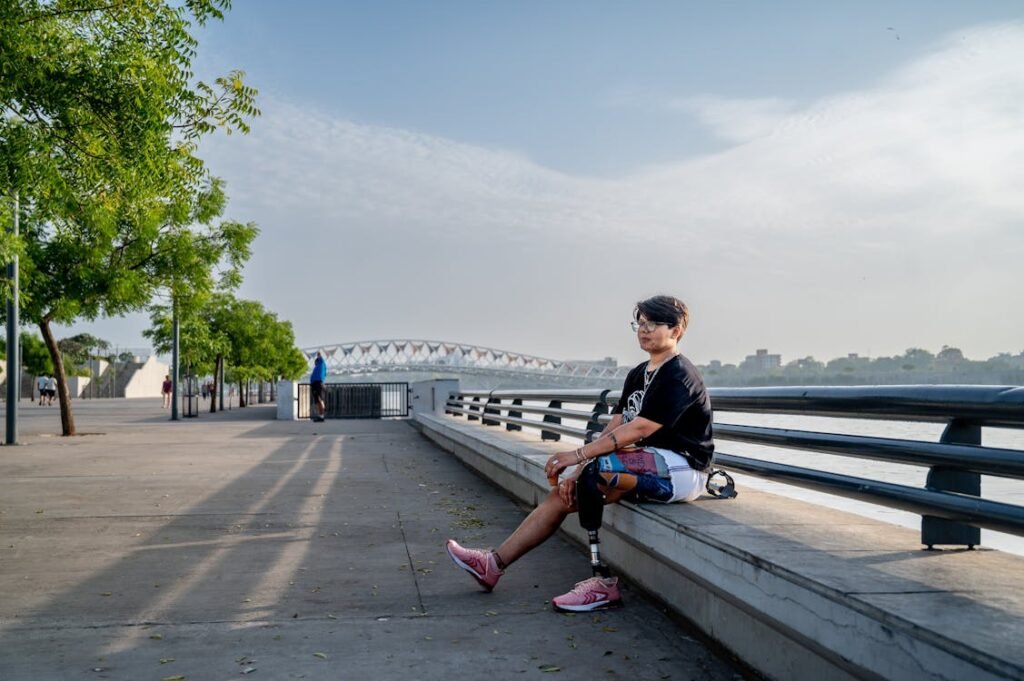
Understanding Weight-Bearing After Lower Limb Amputation
What Is Weight-Bearing and Why It Matters
Weight-bearing means how your body puts weight on your legs and feet. For most people, it’s automatic. You stand, and your legs support your body.
But when someone loses a leg or part of it, the way the body carries weight changes. That change affects everything — how you stand, how you walk, how long you can stay on your feet, and how tired you feel.
After amputation, the remaining limb — often called the residual limb — must now handle pressure and movement in a new way. The socket of the prosthesis becomes the main point where force is applied.
That point needs to be strong, balanced, and in harmony with the rest of the body. If not, problems start to show. You might feel off balance, or one side of the body may work harder than the other.
This throws off your natural rhythm, and that makes your body use more energy.
How the Body Reacts to Changes in Weight-Bearing
The human body is smart. When something changes, it finds ways to adapt. But not all those changes are helpful. After losing a leg, many people begin to shift more weight to the other leg or to their upper body.
This makes walking harder and less efficient. The more you lean or overcompensate, the more energy you burn.
Over time, this can lead to new issues. Back pain, joint pain, muscle strain — all of these can show up when the body is working overtime to make up for lost balance.
That’s why the way you bear weight through your prosthesis matters so much. When your weight is spread evenly and comfortably, your body moves better and uses less energy.
How Prosthetic Design Affects Weight-Bearing
Not all prosthetics are the same. The shape, fit, and alignment of a prosthetic leg can make a huge difference. A well-fitted prosthetic helps distribute weight across the whole limb.
It reduces pressure points and helps keep the socket stable. This lets the amputee walk more naturally, with less effort.
A poor fit, on the other hand, can cause the user to walk unevenly. They may put more pressure on one side, swing the leg too far out, or walk with a limp. All of this adds strain to the body.
Even small adjustments in the angle or height of the prosthesis can change how weight is handled. That’s why proper alignment during fitting is so important.
Prosthetic feet also play a role. Some feet are designed to mimic the natural heel-to-toe roll of a human foot. Others focus on shock absorption or energy return. Each design influences how the body moves and how much effort is needed to walk.
Training the Body to Adjust to Weight-Bearing
Learning to walk again is not just about wearing a prosthetic — it’s about training the body to use it well. This takes time, practice, and guidance. In the early stages, physical therapists often teach amputees how to shift weight safely.
They help build strength in the residual limb, improve posture, and teach proper gait patterns.
Over time, with the right support, amputees can relearn how to distribute weight evenly and walk with less effort. This doesn’t just improve comfort — it also reduces the amount of energy they use every day.
Good training helps avoid bad habits that can cause long-term issues.
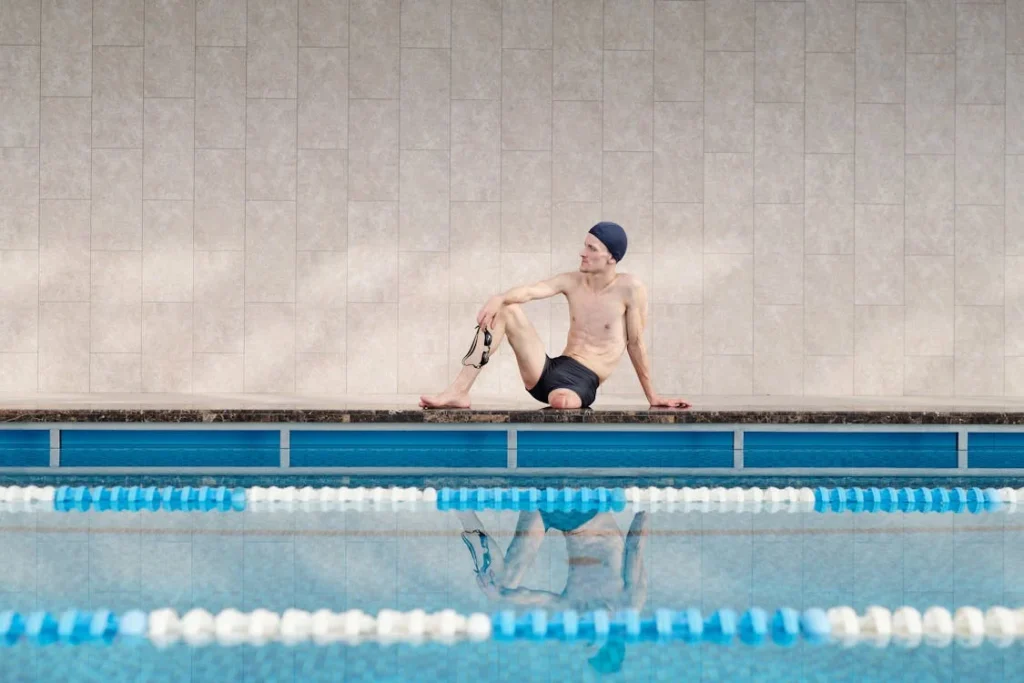
The Energy Cost of Movement in Lower Limb Amputees
Why Movement Takes More Energy After Amputation
Walking seems simple, but it’s a complex action. The body needs to balance, lift, shift, and land—all in a smooth flow. For people with both legs intact, this flow is automatic.
But after an amputation, that rhythm is disrupted. Each movement becomes something you have to think about, and the muscles have to work harder to make up for the missing limb.
The prosthetic limb doesn’t have muscles or nerves. It can’t feel or adjust automatically like a real leg. So, the body overcompensates. It might swing the prosthetic leg farther to clear the ground.
It might hike the hip higher. These are small movements, but they take more effort. Over time, they drain energy faster.
Even standing still takes more effort when the weight isn’t shared evenly. The body is always trying to stay upright.
If weight is not balanced, some muscles stay tense the whole time. That can tire someone out just from standing for too long.
How Poor Weight-Bearing Increases Fatigue
When weight-bearing isn’t balanced, the entire body works against itself. Instead of moving forward with ease, each step becomes a battle against gravity.
Muscles in the lower back, hips, and upper leg might tighten or spasm. The healthy leg may carry more load than it should, leading to fatigue and soreness.
The cardiovascular system also gets more involved. You breathe harder, your heart pumps faster, and the body uses up energy reserves more quickly.
What should be a short walk around the house can feel like a long workout. This isn’t just uncomfortable — it can limit daily activity and independence.
Some people end up avoiding movement altogether because of this. They feel tired more often, rest more, and become less active. This creates a cycle: less movement leads to weaker muscles, which makes walking even harder and more energy-draining.
How Energy Efficiency Can Be Improved Over Time
The good news is that energy efficiency isn’t fixed. It can get better. With time, training, and the right prosthetic setup, many people with lower limb amputations learn to move more easily.
Physical therapy helps teach efficient movement patterns, while strengthening exercises improve muscle support. Even small improvements in weight distribution can make a big difference.
Sometimes, the answer lies in adjusting the prosthesis. A change in foot type or socket alignment may ease strain and improve walking.
In other cases, it’s about improving posture and learning how to move the body more naturally.
Technology also helps. Some advanced prosthetics are designed to store energy and release it with each step, giving a small push forward.
This helps reduce how much effort the user puts into walking. While these aren’t available to everyone, they do show what’s possible when the goal is making movement easier.
For many, simple and consistent rehab can lead to the same kind of improvement. The more the body gets used to balanced movement, the less energy it uses. It becomes a habit — something that feels natural over time.
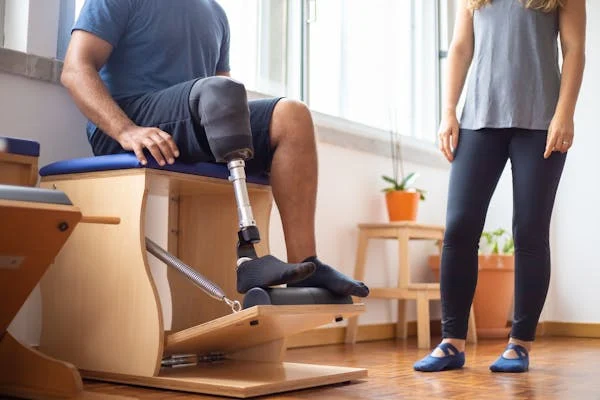
The Role of Socket Fit and Alignment in Energy Efficiency
Why Socket Fit Changes Everything
Think of the socket as the handshake between the body and the prosthetic. If the grip is strong, smooth, and comfortable, things work well. But if the grip is too loose, too tight, or painful, every step becomes a struggle.
When a socket fits poorly, weight-bearing becomes uneven. Pressure builds up in the wrong places, and the residual limb may shift inside the socket.
This instability forces the user to walk unnaturally, which increases the energy cost of every step. It’s like trying to walk in shoes that are too big — you’ll move, but not well, and it takes extra effort to stay steady.
A well-made socket, on the other hand, holds the limb securely while spreading pressure across areas that can safely handle it.
It allows smoother movement and better weight transfer. This reduces the workload on the muscles and joints, helping the user walk farther and longer with less fatigue.
Socket comfort isn’t just physical — it affects confidence too. When the fit feels secure, users are more willing to move freely, try new tasks, and stay active. That kind of mindset leads to better long-term mobility and energy efficiency.
How Alignment Supports Natural Walking
Alignment is how the parts of the prosthetic line up with the body. Even tiny changes in the angle of the socket or the position of the foot can shift how weight moves through the leg.
A small tilt can cause the user to roll the foot differently or bend the knee more than needed. These small inefficiencies add up quickly and make walking harder.
Good alignment helps the prosthesis support the body in a way that feels natural. The foot strikes the ground evenly, the leg moves in a straight line, and the hips stay level. This smooth path allows the body to use energy more efficiently.
When alignment is off, the user may shift weight to avoid discomfort. They might lean forward, tilt sideways, or change how they step. Over time, this can lead to soreness, reduced walking speed, and higher energy use.
That’s why professional alignment checks are so important. It’s not just about comfort — it’s about making sure the prosthesis supports the body’s natural movement, so less effort is needed in each step.
The Importance of Ongoing Fit Adjustments
The human body is always changing. Muscle tone can increase or decrease. The residual limb may shrink or swell.
These changes affect how the prosthetic fits and performs. A socket that felt perfect six months ago might start causing problems if not adjusted in time.
If someone starts feeling new discomfort, or if walking becomes harder, it’s often a sign the socket or alignment needs checking.
Regular follow-ups help catch these issues early, before they turn into long-term energy drains or injuries.
Ongoing care means the prosthesis grows with the user. It adapts to their life, not the other way around. This approach keeps movement efficient, minimizes fatigue, and supports long-term independence.

The Impact of Gait Patterns on Energy Use
How Gait Changes After Amputation
Walking is something most people don’t think about — until it changes. After a lower limb amputation, the way someone walks often becomes very different from before. This change is called a gait deviation.
It might be a limp, a wider step, a swinging leg, or extra movement in the hips or shoulders. These changes are the body’s way of trying to stay upright and keep moving. But they also come with a cost.
Every unusual motion requires energy. If the prosthetic leg doesn’t move exactly like a biological one, the rest of the body steps in to make up for it.
The hip might lift higher to clear the foot. The opposite leg might take longer strides to keep pace. These small actions are not harmful in the short term, but over time, they wear the body down.
Why Gait Efficiency Matters
An efficient gait feels smooth and balanced. Each step follows a rhythm, using muscles in a coordinated way. When the body moves this way, it doesn’t fight itself.
The energy from one step flows into the next. This is what we see in natural walking — it’s not just about strength, it’s about using energy wisely.
For amputees, getting to that smooth rhythm takes effort. The prosthetic leg must be aligned correctly, the socket must fit well, and the user must have enough strength and coordination.
When all those pieces come together, walking becomes easier. Energy use drops. The person feels less tired and can move longer and more confidently.
But if one part is off — a weak muscle, a poor fit, or a bad habit — the gait becomes uneven. Muscles work harder than they need to. Joints move in ways they weren’t built to. Over time, this adds stress and fatigue to the body.
How Training Can Improve Gait and Energy Efficiency
The good news is that gait can be trained. Most people don’t naturally walk well with a prosthesis right away — they learn how. This is where physical therapy becomes critical.
A therapist helps break down the walking process into simple parts. They look at where the movement is breaking down and teach the user how to correct it.
At first, the focus may be on balance. Then it moves to timing, step length, and posture. The therapist might use mirrors, videos, or walking aids to help the user see what’s going wrong and how to fix it.
With practice, these new patterns become habits.
Strength training is also important. Strong core and hip muscles support better control of the prosthetic leg. More control leads to smoother steps and less energy waste.
Flexibility also plays a role, especially in the lower back and hips, which take on more movement after amputation.
Learning to walk efficiently again is not always fast, but it is possible. Each improvement in gait makes a difference — not just in how someone moves, but in how much they can do with the energy they have.
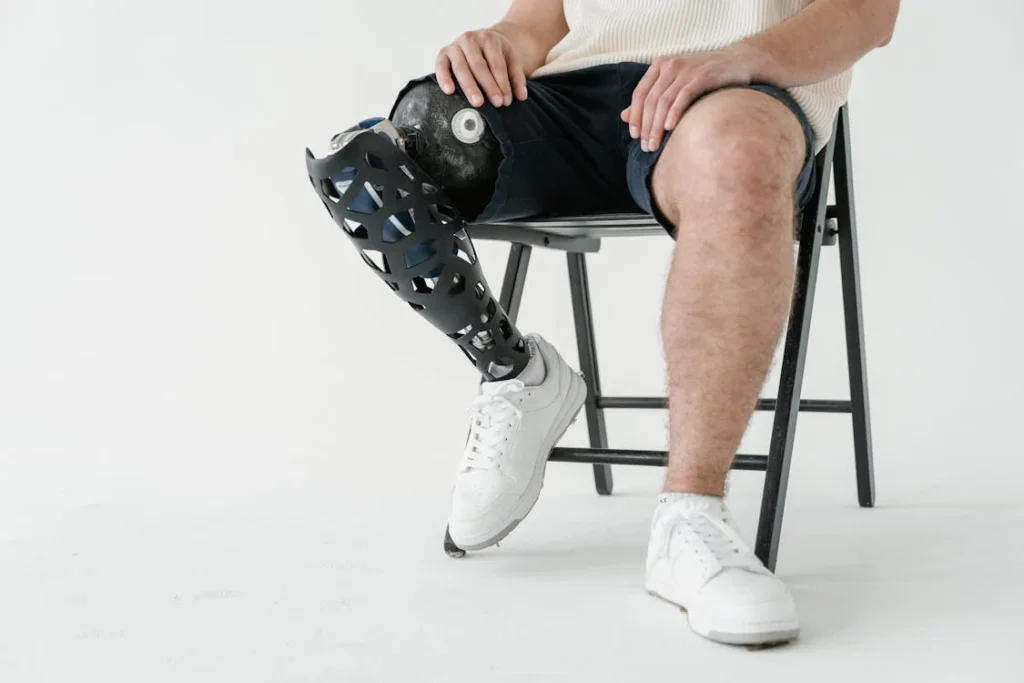
Rehabilitation and Its Role in Restoring Energy Efficiency
Why Rehab Isn’t Just About Walking Again
Many people think rehabilitation is only about learning to walk. But for someone with a lower limb amputation, it’s about far more than that.
Rehab is where the body, mind, and prosthetic all start to work as a team. It’s where energy efficiency is built, one day at a time.
The early days of rehab often focus on healing and preparing the residual limb. But once the prosthesis is fitted, the goal shifts toward movement.
This includes sitting, standing, walking, and even getting up from the floor. Each of these actions involves weight-bearing — and if they’re done incorrectly, they can exhaust the body quickly.
This is why rehabilitation is such a critical part of improving energy use. It teaches the user how to move in a way that feels natural, reduces pressure, and helps muscles work smarter, not harder.
The Power of Muscle Memory
Rehab helps build new muscle memory. The body starts to remember how to move in a balanced way. This is important because without conscious practice, the body may pick up harmful habits.
For example, some amputees unknowingly put more weight on their intact leg. This uneven load might feel easier at first, but it makes movement less efficient and more tiring over time.
Through repetition and guidance, rehab teaches the muscles and brain to work together again. Over time, the prosthetic becomes part of the body’s rhythm.
As that rhythm improves, energy use goes down. Tasks that once felt exhausting become doable. Movements that were shaky become steady.
Gamified Rehabilitation and Motivation
One of the new and exciting changes in rehabilitation is gamification. Turning rehab exercises into games makes the process more engaging and less tiring mentally.
For lower limb amputees, especially young adults and children, this approach works incredibly well. When therapy becomes fun, people stick with it longer. They focus more, move better, and learn faster.
Simple games that involve balance, reaction time, and coordination can improve weight-bearing in small but important ways.
They teach the body how to adjust and correct movements in real time, just like natural walking does. Over time, this playful approach builds serious progress.
Gamified rehab also helps track results. It gives real-time feedb
ack on posture, step length, and weight shifts. This allows the therapist to fine-tune the training and helps the user stay motivated by seeing their progress.
How Rehab Builds Confidence and Reduces Fear
Energy efficiency is not just physical — it’s also emotional. Many new amputees feel nervous about walking. They worry about falling, getting tired, or not being able to keep up.
This fear can hold them back and cause tension in the body. Tension leads to stiffness, and stiffness wastes energy.
Rehabilitation helps remove that fear by building confidence. As users feel stronger and more stable, they begin to trust their body again.
That trust leads to more relaxed movement. And when the body is relaxed, it moves more smoothly, uses less energy, and performs better.
Confidence also encourages activity. When people believe they can move safely and with less effort, they start doing more — walking to the store, standing longer at events, going for short hikes.
These everyday wins boost not just fitness, but independence.
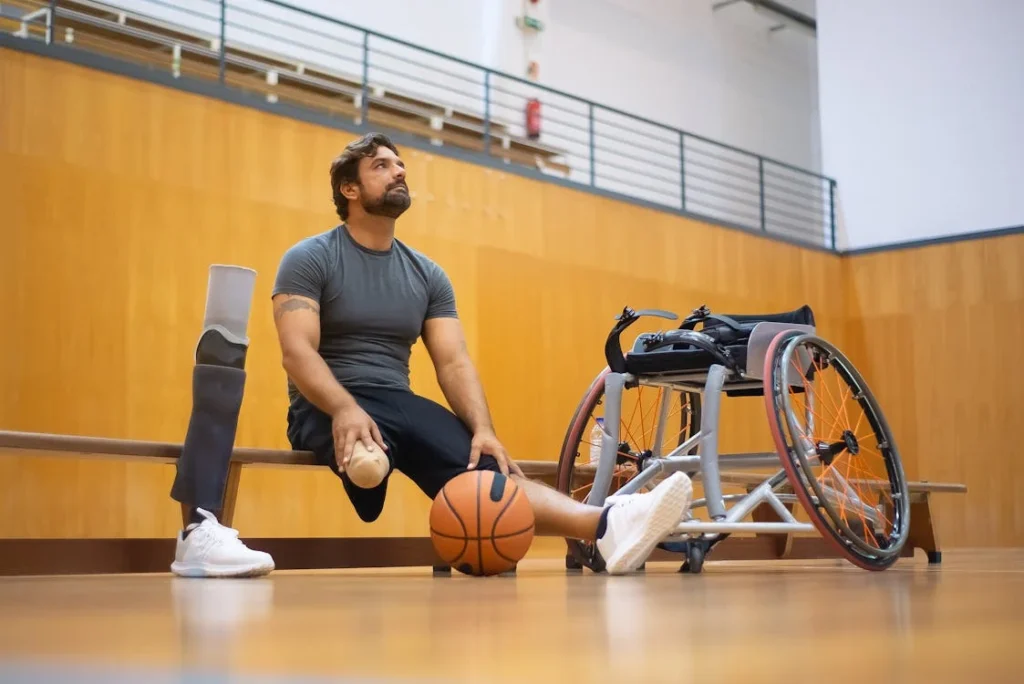
Psychological and Emotional Effects on Energy Use
How the Mind Affects the Body
It’s easy to think of energy as something purely physical. But the truth is, the mind plays a huge role in how the body uses energy—especially for someone living with limb loss.
After an amputation, people often face stress, worry, or even depression. These emotional weights add to the physical effort of walking, standing, and moving through life.
When someone is anxious or tense, their muscles tighten. Their breathing changes. Their heart rate might stay high, even while doing something simple like walking across a room.
This tension eats up energy. It’s like the body is bracing for danger, even if the movement is safe. That’s why managing emotional well-being is key to improving physical energy use.
The first steps toward recovery are not just about movement—they’re also about mindset. Feeling safe, supported, and in control can help the body relax. A relaxed body uses energy more wisely. It’s more in tune, more balanced, and more efficient.
The Fear of Falling and Its Hidden Cost
Many lower limb amputees live with the fear of falling. It makes sense. After all, they’re learning to walk with a new part of their body. This fear often shows up as small hesitations: shorter steps, slower movement, or constantly looking down.
Each of these adds tension to the body. They might not seem like much, but they change how muscles work and how energy flows.
Fear also affects posture. People who are unsure of their footing may hunch their shoulders, lean forward, or shift their center of gravity. These posture changes throw off balance and force the body to use more energy just to stay upright.
Building confidence in walking, especially with help from therapists and support groups, is a quiet but powerful way to reduce wasted energy.
When the mind stops worrying so much about falling, the body starts to move more naturally. That’s when real energy savings begin.
The Role of Motivation and Purpose
People who are motivated tend to move more. That might sound simple, but it matters. When someone has a reason to get out of bed, go outside, and keep improving, they build momentum.
That movement builds strength, builds balance, and builds more energy-efficient habits.
On the other hand, when motivation is low, movement slows. Muscles weaken. Coordination fades. Even small tasks feel tiring. This can start a cycle where low energy leads to less activity, which leads to even lower energy.
That’s why having a purpose—something meaningful to work toward—is so important during recovery. It doesn’t have to be something big.
It could be walking your child to school, joining a community event, or just being able to walk to your garden without resting. These small, clear goals push people to keep going, keep moving, and keep getting better.
Having the right people around also helps. Family, friends, peers, and therapists all shape how someone feels during recovery.
When support is strong and uplifting, people feel less alone. They gain confidence. They start to believe that they can not only move — but move with ease.
Conclusion
Energy efficiency isn’t just about the prosthetic—it’s about how the whole body, and even the mind, comes together to move with purpose and ease. For lower limb amputees, small changes in weight-bearing, alignment, gait, and mindset can make a huge difference. A secure socket, a balanced step, and a confident attitude all help reduce the energy cost of daily life.
Recovery isn’t about rushing. It’s about learning, adapting, and finding a rhythm that works. With the right support, tools, and training, movement becomes more than possible—it becomes empowering. When energy is used wisely, freedom returns.
If you’re on this journey, know this: you don’t have to do it alone. Support, guidance, and smart solutions can help you walk with strength, stability, and less effort every day.



